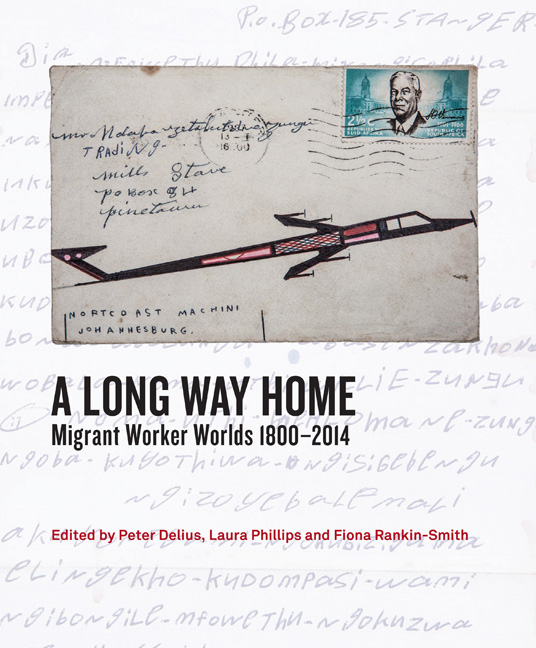Book contents
- Frontmatter
- Contents
- Acknowledgements
- Introduction: Highlighting Migrant Humanity
- Chapter 1 Ngezinyawo - Migrant Journeys
- Chapter 2 Slavery, Indenture and Migrant Labour: Maritime Immigration from Mozambique to the Cape, c.1780–1880
- Chapter 3 Walking 2 000 Kilometres to Work and Back: The Wandering Bassuto by Carl Richter
- Chapter 4 A Century of Migrancy from Mpondoland
- Chapter 5 The Migrant Kings of Zululand
- Chapter 6 The Art of Those Left Behind: Women, Beadwork and Bodies
- Chapter 7 The Illusion of Safety: Migrant Labour and Occupational Disease on South Africa's Gold Mines
- Chapter 8 ‘The Chinese Experiment’: Images from the Expansion of South Africas ‘Labour Empire’
- Chapter 9 ‘Stray Boys’: The Kruger National Park and Migrant Labour
- Chapter 10 Surviving Drought: Migrancy and the Homestead Economy
- Chapter 11 Migrants from Zebediela and Shifting Identities on the Rand, 1930s–1970s
- Chapter 12 Verwoerd's Oxen: Performing Labour Migrancy in Southern Africa
- Chapter 13 ‘Give My Regards to Everyone at Home Including Those I No Longer Remember’: The Journey of Tito Zungu's Envelopes
- Chapter 14 Sophie and the City: Womanhood, Labour and Migrancy
- Chapter 15 Bungityala
- Chapter 16 Migrants: Vanguard of the Worker's Struggles?
- Chapter 17 Debt or Savings? Of Migrants, Mines and Money
- Chapter 18 Post-Apartheid Migrancy and the Life of a Pondo Mineworker
- Notes on Contributors
- List of Figures and Tables
- Index
Chapter 3 - Walking 2 000 Kilometres to Work and Back: The Wandering Bassuto by Carl Richter
Published online by Cambridge University Press: 04 July 2018
- Frontmatter
- Contents
- Acknowledgements
- Introduction: Highlighting Migrant Humanity
- Chapter 1 Ngezinyawo - Migrant Journeys
- Chapter 2 Slavery, Indenture and Migrant Labour: Maritime Immigration from Mozambique to the Cape, c.1780–1880
- Chapter 3 Walking 2 000 Kilometres to Work and Back: The Wandering Bassuto by Carl Richter
- Chapter 4 A Century of Migrancy from Mpondoland
- Chapter 5 The Migrant Kings of Zululand
- Chapter 6 The Art of Those Left Behind: Women, Beadwork and Bodies
- Chapter 7 The Illusion of Safety: Migrant Labour and Occupational Disease on South Africa's Gold Mines
- Chapter 8 ‘The Chinese Experiment’: Images from the Expansion of South Africas ‘Labour Empire’
- Chapter 9 ‘Stray Boys’: The Kruger National Park and Migrant Labour
- Chapter 10 Surviving Drought: Migrancy and the Homestead Economy
- Chapter 11 Migrants from Zebediela and Shifting Identities on the Rand, 1930s–1970s
- Chapter 12 Verwoerd's Oxen: Performing Labour Migrancy in Southern Africa
- Chapter 13 ‘Give My Regards to Everyone at Home Including Those I No Longer Remember’: The Journey of Tito Zungu's Envelopes
- Chapter 14 Sophie and the City: Womanhood, Labour and Migrancy
- Chapter 15 Bungityala
- Chapter 16 Migrants: Vanguard of the Worker's Struggles?
- Chapter 17 Debt or Savings? Of Migrants, Mines and Money
- Chapter 18 Post-Apartheid Migrancy and the Life of a Pondo Mineworker
- Notes on Contributors
- List of Figures and Tables
- Index
Summary
Large-scale and widespread labour migration is often associated with (and explained by) the mineral revolution in South Africa. But long before the creation of the insatiable appetite for black labour, as a result of the growth of the diamond fields in the 1870s, thousands of men from a wide range of societies in what was then the Transvaal and beyond travelled vast distances to seek work in the Cape and Natal. In the 1860s, their main destination was the Eastern Cape – especially Port Elizabeth – which was in the grip of a boom in wool production and export, but the Natal sugar plantations were also an important magnet for migrants. The migrants were largely young men and the missionary Alexander Merensky commented in 1862 that, in the Pedi kingdom, it was an established practice for each youth on reaching maturity to go to the Cape Colony for one or more years. Since maturity was defined sociologically as well as biologically, this comment implies that these youths had passed through the challenging rites of initiation and had been constituted into regiments under royal authority. They usually travelled in large groups and were more than ready to defend themselves against predators and attempts to rob or press-gang them. It was this system that was reoriented and transformed by the discovery of diamonds in Kimberley and then gold on the Rand.
Recent research has also underscored that travelling over long distances and for long periods in pursuit of income and employment was far from novel for the inhabitants of the interior. For centuries, people had travelled the long-distance trade routes that spanned the interior of most of modern southern Africa. Locally manufactured iron and copper goods, salt, ochre, horns, skins, pots, grain and cattle were traded over both short and long distances. These trade networks also connected to routes that linked to the east coast, which brought imported beads, cloth, ceramics and metalware to the interior and exported ivory, other products of the hunt and some cattle. Often, the paths that migrant workers walked on their way to work had been long-established trade routes.
The pursuit of employment also shaped movement long before the nineteenth century.
- Type
- Chapter
- Information
- A Long Way HomeMigrant Worker Worlds 1800–2014, pp. 49 - 58Publisher: Wits University PressPrint publication year: 2014

